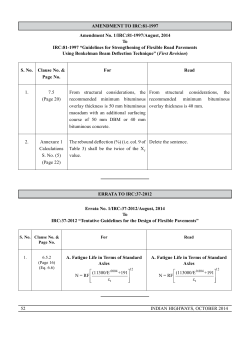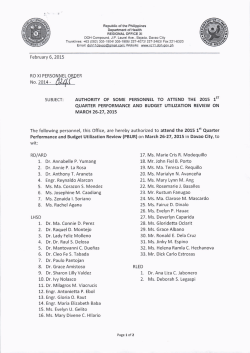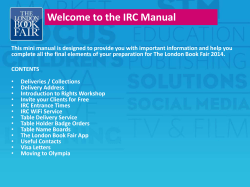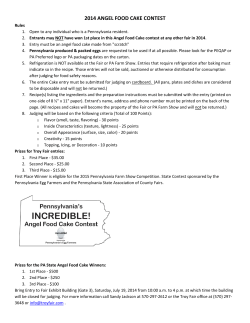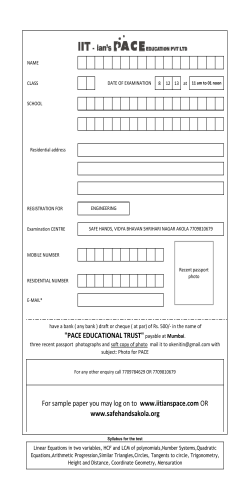
Training Manual Pennsylvania's Uniform Construction Code (UCC) (ACT 45 of 1999) and
8/29/2014 Training Manual Details Training Manual Pennsylvania's Uniform Construction Code (UCC) (ACT 45 of 1999) and International Residential Code IRC "Just tell me what I need to know!" This manual is intended for use with the following training programs: GA1 - Comprehensive International Residential Code GA2 - CABO to BOCA Transition CO1 - Comprehensive International Residential Code for Code Officials Cost of manual: $50.00 GO TO=> TABLE OF CONTENTS or PREFACE AND ACKNOWLEDGEMENTS Developed by: Pennsylvania Housing Research Center Date: Last Updated => August 2003 http://www.engr.psu.edu/phrc/pubs/tm01.htm 1/8 8/29/2014 Training Manual Details Table of Contents 1. The Pennsylvania Uniform Construction Code (Act 45) 1.1 1.2 1.3 1.4 1.5 1.6 1.7 1.8 2. Administration 2.1 2.2 2.3 2.4 2.5 2.6 2.7 2.8 2.9 2.10 2.11 2.12 3. Enactment and Enforcement Effective date of the UCC Status of regulation development Legislated exemptions and exclusions Residential and non-residential separated (IRC & IBC) Requirements for residential building and remodeling contractors Enforcement options Requirements for code officials General purpose of building codes R101.3 Overview of the IRC Scope of IRC R101.2 IRC Permit Exemptions R105.2 Overview of building regulations Building permits Inspections R109 Violations R113 Certificate of occupancy R110 Referenced standards R102.4 Definitions R202 Questions to ask your code official Building Planning 3.1 3.2 3.3 3.4 3.5 3.6 3.7 3.8 3.9 3.10 3.11 3.12 3.13 3.14 3.15 3.16 Design criteria R301 Live loads, dead loads, snow loads Location on and setback requirements R302 Lighting and ventilation requirements R303.1 Minimum room areas R304 Minimum ceiling heights and clearances R305 Sanitation and bathroom requirements R306 – R307 Glazing R308 Garages and carports R309 Emergency escape and rescue openings R310 Means of egress R311 Smoke alarms R313 Foam plastic R314 Flame spread and smoke density R315 Insulation material R316 Dwelling unit separation R317 http://www.engr.psu.edu/phrc/pubs/tm01.htm 2/8 8/29/2014 Training Manual Details 3.17 Moisture vapor retarders R318 3.18 Protection against decay and termites R319 & R320 3.19 Flood-resistant construction R323 4. Energy Conservation 4.1 4.2 4.3 5. Foundations 5.1 5.2 5.3 5.4 5.5 5.6 5.7 5.8 6. Lumber grading and sheet goods identification Span Tables R502 Construction and Design Details R502.2 Draftstopping of floor systems R502.12 Floor sheathing R503 Concrete slabs (on ground) R506 Walls and Wall Coverings 7.1 7.2 7.3 7.4 7.5 7.6 7.7 8. Soils Footing requirements R403.1-R403.5 Anchor bolts and fasteners R403.1.6 Foundation walls R404 Drainage, dampproofing and waterproofing R405 Columns Crawlspaces (under floor spaces) R408 Frost-protected shallow foundations R403.3 Floor 6.1 6.2 6.3 6.4 6.5 6.6 7. General requirements N1101 Pennsylvania climate zones Building envelope N1102.1 Wood framing R602 Fireblocking requirements R602.8 Masonry Exterior windows and glass doors R613 General—installation R701 Interior coverings R702 Exterior coverings R703 Roof-Ceiling 8.1 8.2 8.3 8.4 8.5 Wood roof framing R802 Trusses R802.10 Roof sheathing R803 Roof ventilation R806 Attic access R807 http://www.engr.psu.edu/phrc/pubs/tm01.htm 3/8 8/29/2014 Training Manual Details 8.6 8.7 8.8 8.9 8.10 Roof classifications R902 Weather protection R903 Roof covering R905 Roof insulation R906 Requirements for “re-roofing” R907 9. Chimneys, Fireplaces, Mechanical Systems and Fuel Gas 9.1 Masonry chimneys R1001 9.2 Factory-built chimneys R1002 9.3 Masonry fireplaces R1003 9.4 Factory-built fireplaces R1004 9.5 Fireplace exterior air supply R1005 9.6 General mechanical system requirements M1301 9.7 Equipment access M1305 9.8 Appliance installation M1307 9.9 Heating and cooling equipment sizing and installation M1401 - M1414 9.10 Exhaust system M1501-1505 9.11 Duct systems 9.12 Combustion air 9.13 Special fuel-burning equipment 9.14 Fuel gas Chapter 24 10. Plumbing 10.1 10.2 10.3 10.4 10.5 10.6 Compliance with international plumbing code Plumbing administration general P2501 Plumbing fixtures and water heaters P2701 Water supply and distribution P2901 Sanitary drainage P3000 Vents and traps 11. Electrical 11.1 11.2 11.3 11.4 11.5 11.6 11.7 General provisions Electrical service sizing – load calculations E3502.2 Methods of installation Power and lighting distribution Clearances for overhead service E3504.1 Installation issues Swimming pools, spas, hot tubs—equipment locations and clearances E4103 Attachments Plan Submittal Checklists Attachment A Sample Plans Attachment B http://www.engr.psu.edu/phrc/pubs/tm01.htm 4/8 8/29/2014 Training Manual Details Building Material Weight Attachment C Sample Documentation (Alt. Materials or Designs) Attachment D Sample Heating Cooling Load Calculations Attachment E http://www.engr.psu.edu/phrc/pubs/tm01.htm 5/8 8/29/2014 Training Manual Details <<GO TO TOP>> http://www.engr.psu.edu/phrc/pubs/tm01.htm 6/8 8/29/2014 Training Manual Details Preface and Acknowledgements Residential builders, remodelers and subcontractors in Pennsylvania face interesting challenges over the next few years! For those who have never or rarely worked in municipalities with enforced building codes, passage of the Uniform Construction Code (Act 45 of 1999) means their business will become regulated in a number of ways that will require changes in how they operate --- from plan review and approval, through onsite inspections to occupancy permits. The code that will become Pennsylvania’s Uniform Construction Code—and will therefore govern the building of most houses and townhouses in Pennsylvania—is the International Residential Code (IRC). The IRC is published by the International Code Council (ICC) and is one of a family of codes that the Council produces. The focus of this manual (and of this training program) is on the changes that the IRC introduces as well as the new requirements that Pennsylvanian builders, remodelers and subcontractors as well as building code officials need to know about. The manual is not—and is not intended to be—a substitute for the IRC book. Participants in this training program need to have their own copy of the IRC book on hand to refer to throughout the program. Nor does the manual attempt to cover all topics, even briefly. Instead, it identifies the key changes and key new requirements and tells you exactly where to find the relevant sections in the IRC book. The Attachments contain additional information and examples that may be of use and interest to you. We hope you will use the manual to improve your understanding of the Uniform Construction Code and the International Residential Code. This project received financial and other support from the following: · the Pennsylvania Builders Association; · the individuals, associations, and corporations that are members of the PHRC; · the Pennsylvania State University; and · the U.S. Department of Energy. This document was written by Robert Buddenbohn and Mark Fortney, Director of the PHRC and co-authored by Ken Sagan, Training, Education and Development Specialist of the PHRC. The assistance of Michelle McMullen and Angela Burnett in producing the final version of this report is appreciated. We would like to thank the following individuals for sharing their expertise and providing input and guidance throughout the development of this manual: Larry D. Armanda Lou Biacchi Tim Britton Robert Buddenbohn Harry Burd, M.C.O. Eric Burnett, P. Eng. http://www.engr.psu.edu/phrc/pubs/tm01.htm 7/8 8/29/2014 Training Manual Details David J. Buskirk Paul Campbell Scott Cannon Cindy Davis Richard Druckenmiller John M. Eastman, CRI Chuck Farrell Mark Fortney Jeffrey A. Frazier Jeffrey Gentile, P.E. A. Sheldon Glahn Lynn Hatton George R. Jerus, P.E. Fred Kinder A. Clyde Kreider Edward A. “Ned” Liggett Jake Loyer Joe Mackey James Matscherz Doug Meshaw C. Lee Milligan, CBO Gene Minnick Merle Musick Jim Royer Rodney Sarver Thomas E. Sauers, CBI/BO Robert Smith Jason Stevens Don Surrena Frank Thompson Tom Woodson The PHRC was responsible for initiating and producing this manual. Two of our more general objectives are to stimulate discussion about housing and to promote the development of better and more affordable housing in Pennsylvania. We therefore welcome questions or other feedback regarding this manual. <<GO TO TOP>> http://www.engr.psu.edu/phrc/pubs/tm01.htm 8/8
© Copyright 2025

